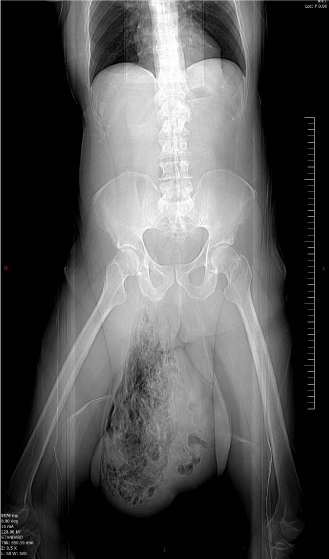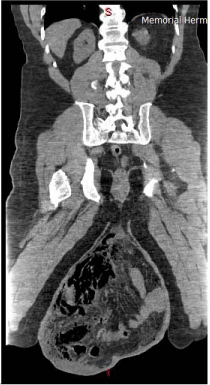Case Report
Groin Pain: A Case of a Giant Inguinal Hernia with Duodenal Perforation
Chebl RB1 *, Madden B2 and Iversen C3
1Department of Emergency Medicine, American University of Beirut, Lebanon
2Department of Emergency Medicine, Memorial Hermann Hospital, Texas
*Corresponding author: Ralphe Bou Chebl, American University of Beirut Medical Centre, Department of Emergency Medicine, Beirut, Lebanon
Published: 22 Aug 2016
Cite this article as:Chebl RB, Madden B, Iversen C. Groin
Pain: A Case of a Giant Inguinal Hernia
with Duodenal Perforation. Ann Clin
Case Rep. 2016; 1: 1090.
Abstract
Introduction: Giant inguinal hernias are defined as those extending below the midpoint of the inner thigh, in the standing position. They are extremely rare, accounting for approximately 0.5%
of inguinal hernias.
Case Report: We describe a case of a 62-year Hispanic old male who presented to a community
hospital Emergency department with groin pain. The patient was found to have a giant inguinal
hernia on physical exam. On CT scan, he was found to have duodenal herniation and perforation
within the hernia. The patient later developed septic shock and was taken to surgery for operative
repair. Despite operative intervention, the patient passed away.
Conclusion: This is a case of septic shock resulting from a herniated and perforated duodenum as
well as a review of the literature on giant inguinal hernias and their management in the emergency
department.
Keywords: Giant inguinal hernia; Septic shock; Duodenum; Perforation
Abbreviations
CT: Computerized Tomography; mmHg: Millimeters of Mercury; BPM: Beats Per Minute; SaO2: Oxygen Saturation; WBC: White Blood Cells; ICU: Intensive Care Unit; IV: Intravenous
Introduction
An inguinal hernia is a protrusion of the contents of the abdominal cavity or peritoneal fat througha defect in the inguinal area [1]. The hernia sac contents are at risk of incarceration, which may lead to more serious sequelae such as bowel obstruction, and or a circulatory strangulation of the hernia contents, leading to necrosis and possible perforation of the intestine [1]. The chance of incarceration is relatively low, between 0.3-3% per year [2-4]. Giant inguinal hernias are defined as those extending below the midpoint of the inner thigh in the standing position. These hernias are rare, accounting for approximately 0.5% of inguinal hernias in one study [5]. The aim of this paper is to report on a case of massive strangulated inguinal hernia with duodenal perforation.
Case Presentation
A 62-year-old Hispanic male with a reported history of “testicular elephantiasis” since he was a teenager presented to a small free-standing emergency department with a complaint of groin pain.
He stated that he was lifting something heavy two days prior and began having right-sided groin
and testicular pain. Furthermore, he was complaining of nausea and vomiting and added that he
had not passed gas or had a bowel movement for last two days. Prior to today’s visit, he had not seen
a doctor in decades.
On arrival to the emergency department he appeared to be in moderate pain. His initial vital
signs were as follows: temperature of 36.6°C, heart rate of 126 bpm, blood pressure of 191/119
mmHg, respiratory rate of 21, and SaO2 of 100 % on room air. His cardiac exam was remarkable
for tachycardia. His abdominal exam was remarkable for right lower quadrant and suprapubic
tenderness as well as decreased bowel sounds. His genitourinary exam demonstrated a massively
distended scrotum extending to his knees with diffuse tenderness worse on right side. His lower
extremity exam was unremarkable.
He was given Morphine, Zofran, and a 1L IV fluid bolus.
Significant labs were as follows: creatinine 3.4 mg/dL, BUN 36 mg/dL,
glucose 135 mg/dL, lipase 2, 141 unit/L, WBC 6.5, Hgb 13.4, lactate
9.9 mMol/L. A CT abdomen/pelvis with oral contrast demonstrated
a massive right inguinal hernia containing parts of the stomach,
all of the small bowel, part of the colon, as well as free air and fluid
suggestive of perforation most likely originating from the duodenum;
the appendix was not visualized with certainty (Figure 1 and 2).
He was given Ceftriaxone and Metronidazole intravenously.
General surgery was then consulted and transfer was initiated to a
higher acuity facility.
After transfer he was immediately taken to the operating room.
During surgery he was found to have a large perforation in the second
and third portion of the duodenum. He also required resection of the
distal small bowel, right colon, and part of the mid transverse colon.
Postoperatively he was transferred to the ICU in stable condition.
However the patient began to deteriorate throughout the night.
He went into multiorgan failure requiring aggressive IV fluids,
dialysis, and multiple vasopressors. Despite these efforts, lactate
increased to 29.3 mMol/L and the patient went into asystolic cardiac
arrest and passed away.
Figure 1
Discussion
Inguinal hernias account for 75% of abdominal wall hernias;
with a lifetime risk of 27% in men and 3% in women [6]. They are
often classified as direct or indirect, depending on whether the hernia
sac bulges directly through the posterior wall of the inguinal canal
(direct) or passes through the internal inguinal ring alongside the
spermatic cord following the course of the inguinal canal (indirect)
[6]. Inguinal hernias are reducible if they occur with straining and
can be pushed back into the abdominal cavity. They are at risk ofincarceration, which occurs when the herniated bowel loops remain
outside the abdominal cavity. Incarcerated hernia may lead to bowel
strangulation and bowel obstruction.
Giant inguinoscrotal hernias are defined as those extending
below the midpoint of the inner thigh, in the standing position [5].
The contents of giant inguinal hernias are usually bowel loops, but
there are case reports of giant hernias containing stomach, ovaries
and the bladder [7-9]. They are usually recurrent hernias and reach
large dimensions either because of patients’ reluctance to undergo
surgical treatment, or because the surgeon’s advice against it due
to technical difficulties such as cardiorespiratory compromise [5].
Compared to inguinal hernias, the recurrence is much higher in giant
inguinoscrotal hernias. These hernias pose a significant amount of
morbidity, as patients have voiding difficulty and develop urinary
retention [10], as well as scrotal skin thickening and testicular atrophy.
Traditionally giant inguinal hernias are treated with progressive
pneumoperitoneum. The recommended method is by injecting 100
to 500mL of air daily over 15 days through an intraperitoneal catheter
[10]. Pneumoperitoneum is however not very effective because the
air insufflation causes enlargement of the hernia sac, rather than
the abdominal cavity. Progressive pneumoperitoneum is however
contraindicated in patients with strangulated hernias and infection
[11]. As these giant inguinoscrotal hernias are usually chronic, the
abdominal cavity adapts to being empty and reduces its size, which is
referred to as loss of domain. Sudden replacement of the large bowel
contents into the abdominal cavity causes an abrupt increase in
intra abdominal and intra thoracic pressure. The increased pressure
can lead to an impaired diaphragmatic motion and reduced venous
return. Furthermore, the distention of abdominal skin exerts tension
on the postoperative wound, which significantly impairs healing [4].
Several case reports have described hemicolectomy, omenectomy,
splenectomy, small bowel resection, and even phrenectomyas
treatment modalities for giant inguinoscaral hernias [12,13]. The
scrotal skin may be left intact because it can be used for decompression
if the patient develops respiratory compromise post operatively.
The post operative recovery for these patients is characterized by a
prolonged duration of elective mechanical ventilation. Ventilation
for a minimum period of 10 days in the intensive care unit has been
suggested [5].
Given the gravity and acuity of our patient’s presentation, he
underwent both a small bowel resection and partial colectomy. It
is unknown if loss of domain contributed to our patient’s decline
given he had perforation with spillage of bowel contents at the time
of surgery. To our knowledge this is the first case of perforated
duodenum into the scrotum. Unfortunately, we could not save this
patient despite early surgery and aggressive sepsis treatment. It is
likely the patient had lived with a large inguinal hernia for a long
period of time, and given the initial labs and vitals, it is very possible
he presented soon after perforation. This present case suggests that a
strangulated hernia with duodenal perforation into the scrotum has a
very high mortality rate despite early and aggressive treatment.
Figure 2
Conclusion
Giant inguinoscrotal hernias are rare but they carry a high mortality and morbidity. The mainstay of treatment remains surgical after proper stabilization of the patient. Several organs can herniate through the sac and it is important to note that small bowel can perforate into the hernia sac and further worsen the mortality.
References
- Simons MP, Aufenacker T, Bay-Nielsen M, Bouillot JL, Campanelli G, Conze J, et al. European Hernia Society guidelines on the treatment of inguinal hernia in adult patients. Hernia : the journal of hernias and abdominal wall surgery. 2009; 13: 343-403.
- Gallegos NC, Dawson J, Jarvis M, Hobsley M. Risk of strangulation in groin hernias. Br j of surg. 1991; 78: 1171-1173.
- Post S. [Against the principle surgical indications in inguinal hernia]. Der Chirurg; Zeitschrift fur alle Gebiete der operativen Medizen. Dec 1997; 68(12):1251-1255; discussion 1256-1257.
- Hodgkinson DJ, McIlrath DC. Scrotal reconstruction for giant inguinal hernias. Mayo Clinic proceedings. 1982; 57: 383-386.
- Karthikeyan VS, Sistla SC, Ram D, Ali SM, Rajkumar N. Giant inguinoscrotal hernia--report of a rare case with literature review. International surgery. 2014;99 : 560-564.
- Jenkins JT, O'Dwyer PJ. Inguinal hernias. Bmj. 2008; 336: 269-272.
- Weitzenfeld MB, Brown BT, Morillo G, Block NL. Scrotal kidney and ureter: an unusual hernia. The Journal of urology. Mar 1980;123(3): 437-438.
- Udwadia TE. Stomach strangulated in inguinal hernia presenting with hematemesis. International surgery. 1984; 69: 177-179.
- Birnbaum DJ, Gregoire E, Campan P, Hardwigsen J, Le Treut YP. A large inguinoscrotal hernia with stomach content. ANZ journal of surgery. Jan 2011; 81(1-2): 86-87.
- Tahir M, Ahmed FU, Seenu V. Giant inguinoscrotal hernia: case report and management principles. International journal of surgery. 2008; 6: 495- 497.
- Moreno IG. Chronic eventrations and large hernias; preoperative treatment by progressive pneumoperitomeum; original procedure. Surgery. 1947; 22: 945-953.
- Coetzee E, Price C, Boutall A. Simple repair of a giant inguinoscrotal hernia. International journal of surgery case reports. 2011; 2: 32-35.
- Patsas A, Tsiaousis P, Papaziogas B, Koutelidakis I, Goula C, Atmatzidis K. Repair of a giant inguinoscrotal hernia. Hernia : the journal of hernias and abdominal wall surgery. 2010; 14: 305-307.


